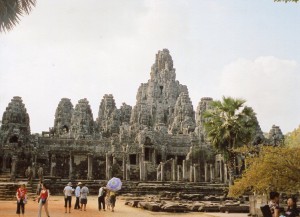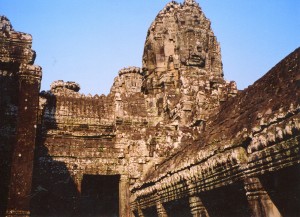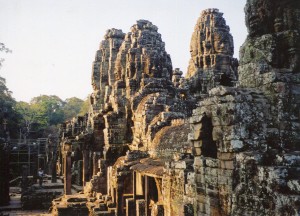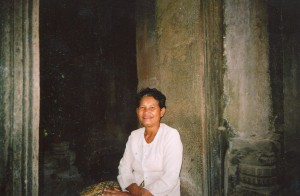Yesterday’s post on the Bayon was supposed to be the last in a series, but I knew this post was coming.
Nobody has wrapped his mind around the Bayon yet. Even specialists see new meanings in the most fascinating Khmer temple besides Angkor Wat. We’ll explore one of the more interesting theories about it today.
Just who are those guys on the face towers? Many scholars have said that they’re the Mahayana deity Lokesvara, in the likeness of the king who built the Bayon, Jayavarman VII. But Peter D. Sharrock, a contributor to Bayon, New Perspectives (a great book), proposes a very different idea.
He sees Tantric influence in the Bayon. Tantrism flourished in northern India in the Middle Ages, and its many practices emphasized yogic techniques for becoming conscious of the unity of all things. A Buddhist yogi is thus supposed to achieve Buddha-nature.
Sharrock thinks that the face towers depict, not the king, but a tantric deity called Vajrasattva. He was an early manifestation of the Buddha. The Bayon’s profusion of faces thus might represent the Buddha emanating throughout the whole universe. His nature permeates every inch of the cosmos. The Bayon’s huge wedding cake form might embody a spiritual universe before it condensed into solid matter.
Sharrock argues that the faces on the towers don’t look like Lokesvara or Jayavarman VII. Surviving portraits of the latter show a sturdy military man with a bull neck and the paunch of a middle-aged king who substituted banquets for battles.
Many monks in Northern India practiced Tantrism when Jayavarman took the throne. But in 1197, Islamic armies from Afghanistan swept through the Ganges area, ransacked the monasteries, and butchered thousands of monks. Many who escaped fled to Cambodia, and some might have inspired its king, who had recently embraced Buddhism.
This is just a theory. It’s plausible, but not a fact. But I’m sharing it with you to emphasize two things about the Khmers:
1. Ideas in the Khmer empire were very diverse. Angkor was regularly in contact with India, several other Southeast Asian states and China. Hiram Woodward wrote that the Chinese emperor’s ascent up Mount Tai might have inspired Khmers to build some of their towers. Indian ideas of Mount Meru and Shiva’s power, and local veneration of hills and their spirits certainly influenced Khmer temples. But the Khmers were well used to fusing different ideas. There was probably a bigger range of ideas behind the Bayon than most people have thought.
2. Khmer studies is a vibrant field. These temples live–they inspire new research and interpretations. The faces gaze in all directions, and people from all directions look towards it and find inspiration. Count me as one–I’ll be back there in a few months with eyes wide open.





Comments on this entry are closed.